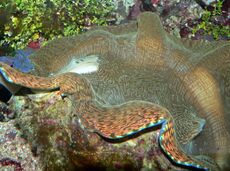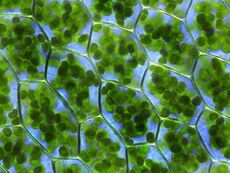Earth:Photosymbiosis
Photosymbiosis is a type of symbiosis where one of the organisms is capable of photosynthesis.[1]
Examples of photosymbiotic relationships include those in lichens, plankton, ciliates, and many marine organisms including corals, fire corals, giant clams, and jellyfish.[2][3][4]
Photosymbiosis is important in the development, maintenance, and evolution of terrestrial and aquatic ecosystems, for example in biological soil crusts, soil formation, supporting highly diverse microbial populations in soil and water, and coral reef growth and maintenance.[5][6]
When one organism lives within another symbiotically it’s called endosymbiosis. Photosymbiotic relationships where microalgae and/or cyanobacteria live within a heterotrophic host organism, are believed to have led to eukaryotes acquiring photosynthesis and to the evolution of plants.[7][8]
References
- ↑ "photosymbiosis". https://www.oxfordreference.com/display/10.1093/oi/authority.20110803100324758;jsessionid=FFCC5585B976D5CF87DDD905A035A006.
- ↑ "Lineage-specific variation in the evolutionary stability of coral photosymbiosis". Science Advances 7 (39): eabh4243. 2021. doi:10.1126/sciadv.abh4243. PMID 34550731. Bibcode: 2021SciA....7.4243G.
- ↑ Decelle, Johan (2013). "New perspectives on the functioning and evolution of photosymbiosis in plankton: Mutualism or parasitism?". Communicative & Integrative Biology 6 (4): e24560. doi:10.4161/cib.24560. PMID 23986805.
- ↑ "Living Inside a Jellyfish: The Symbiosis Case Study of Host-Specialized Dinoflagellates, "Zooxanthellae", and the Scyphozoan Cotylorhiza tuberculata". https://www.researchgate.net/publication/359083782.
- ↑ "Lineage-specific variation in the evolutionary stability of coral photosymbiosis". Science Advances 7 (39): eabh4243. 2021. doi:10.1126/sciadv.abh4243. PMID 34550731. Bibcode: 2021SciA....7.4243G.
- ↑ "Photosymbiosis: The Driving Force for Reef Success and Failure". The Paleontological Society Papers 17: 33–59. 2011. doi:10.1017/S1089332600002436. https://www.cambridge.org/core/journals/the-paleontological-society-papers/article/abs/photosymbiosis-the-driving-force-for-reef-success-and-failure/440B3D3EF85F378727A46780D2F1F23A. Retrieved 2023-06-18.
- ↑ Decelle, Johan (2013). "New perspectives on the functioning and evolution of photosymbiosis in plankton: Mutualism or parasitism?". Communicative & Integrative Biology 6 (4): e24560. doi:10.4161/cib.24560. PMID 23986805.
- ↑ Basic Biology (18 March 2016). "Bacteria". https://basicbiology.net/micro/microorganisms/bacteria.
 |







